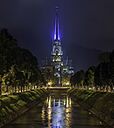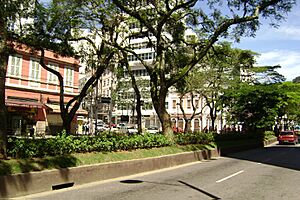Petrópolis facts for kids
Quick facts for kids
Petrópolis
|
|||
|---|---|---|---|
|
Municipality
|
|||
| Municipality of Petrópolis | |||
|
From upper left: skyline of downtown, city's Cathedral, Imperial Museum, Imperador street, Crystal Palace and Quitandinha Palace.
|
|||
|
|||
| Nickname(s):
The Imperial City
|
|||
| Motto(s):
"Altiora Semper Petens"
(Latin for "Always seeking higher things") |
|||

Location of Petrópolis in the state of Rio de Janeiro
|
|||
| Country | |||
| Region | Southeast | ||
| State | |||
| Founded | 16 March 1843 | ||
| Named for | Pedro II of Brazil | ||
| Government | |||
| • Type | Mayor-council | ||
| Area | |||
| • Total | 795.798 km2 (307.259 sq mi) | ||
| Elevation | 838 m (2,749 ft) | ||
| Population
(2022)
|
|||
| • Total | 278,881 | ||
| • Rank | 99th | ||
| • Density | 384.42/km2 (995.6/sq mi) | ||
| Demonym(s) | petropolitano | ||
| Time zone | UTC−3 (BRT) | ||
| Postal Code |
25680-000
|
||
| Area code(s) | +55 24 | ||
| HDI (2010) | 0,745 – high (UNDP) | ||
| Website | www.petropolis.rj.gov.br | ||
Petrópolis is a city in the Southeast Region of Brazil. It is also known as The Imperial City. The city is located in the state of Rio de Janeiro, about 68 kilometers (42 miles) northeast of the city of Rio de Janeiro. In 2022, Petrópolis had a population of 278,881 people. It is the largest and most populated city in the Fluminense Mountain Region.
The name "Petrópolis" means "City of Peter." It honors Pedro II, who was the last Emperor of Brazil. His tomb is in the Cathedral of Saint Peter of Alcantara in the city. In the 1800s, Petrópolis was the summer home for Brazilian Emperors and important families. It was also the official capital of the state of Rio de Janeiro from 1894 to 1902.
Contents
- Petrópolis: A City with a Rich Past
- Geography and Climate of Petrópolis
- People and Culture of Petrópolis
- Economy and Tourism in Petrópolis
- Education and Transport in Petrópolis
- Arts and Celebrations in Petrópolis
- Media and Communications
- Sister Cities
- Famous People from Petrópolis
- Images for kids
- See also
Petrópolis: A City with a Rich Past
Early History of Petrópolis
![]() Empire of Brazil 1843–1889
Empire of Brazil 1843–1889
![]() Republic of Brazil 1889–present
Republic of Brazil 1889–present
Before the 1700s, native people called índios coroados lived in this area. The Portuguese named it "Sertão dos Índios Coroados," meaning "Backlands of the Crowned Indians." Later, gold was found in Minas Gerais. A new road, the "Caminho Novo das Minas" (New Road to Mines), was opened through Petrópolis. This led to more people settling in the region.
The Imperial Era and Growth

In 1822, Emperor Pedro I visited the area and liked its cool climate. He bought land there in 1830, planning to build a summer palace. However, he left the throne before it was finished.
His son, Emperor Pedro II, continued his father's dream. On March 16, 1843, he ordered a new town to be built. German immigrants helped to form this new settlement. The Emperor laid the first stone for the summer palace in 1845, and it was ready in 1847. This made Petrópolis one of Brazil's first planned cities.
Petrópolis then became the unofficial summer capital of the Empire of Brazil. The entire royal court would move there. Many wealthy people from Rio de Janeiro also came to escape yellow fever outbreaks. Emperor Pedro II spent many summers in Petrópolis during his 49-year rule. In 1857, the town officially became a city.
Important developments happened in Petrópolis. In 1861, Brazil's first paved highway, Estrada União e Indústria, opened. It connected Petrópolis to Juiz de Fora. A railroad arrived in 1883, thanks to the Baron of Mauá. In 1877, the first telephone line in Brazil was set up here. It connected the Emperor's palace to his farm.
Petrópolis in the Republic
Even after Brazil became a Republic in 1889, Petrópolis remained important. It was a favorite summer spot for Brazilian Presidents. They stayed at the Palácio Rio Negro (Black River Palace). Getúlio Vargas, a famous president, often stayed there for months.
From 1894 to 1902, Petrópolis was the capital of the State of Rio de Janeiro. This happened because of two Navy Revolts. In 1903, the Treaty of Petrópolis was signed here. This treaty gave Brazil the Acre territory from Bolivia. During World War II, a meeting at the Quitandinha Palace led American countries to declare war on the Axis Powers.
In 1973, the remains of Isabel, Princess Imperial of Brazil and her husband were brought to Petrópolis. They were buried in the Imperial Mausoleum. Princess Isabel received a special funeral, like a Head of State.
Sadly, on February 15, 2022, Petrópolis faced heavy floods. Intense rainfall caused mudslides, and over 150 people lost their lives.
Geography and Climate of Petrópolis
Petrópolis is located among the green hills of the Serra dos Órgãos mountain range. It sits in the valleys of the Quitandinha and Piabanha rivers. It is a popular place for winter holidays. A main attraction is the former Summer Palace of the last Brazilian Emperor. Today, it is the Imperial Museum of Brazil, full of items from Brazil's imperial past.
The city has a humid subtropical climate. This means it has humid summers. The average rainfall is about 1383 millimeters (54 inches) per year. Temperatures are usually mild. The yearly average is around 19°C (66°F). In warmer months, the average is 23°C (73°F). In colder months, it's about 15°C (59°F).
| Climate data for Petrópolis (Granja Jurity), elevation 980 m (3,220 ft), (1981–2010 normals, extremes 1986–2007) | |||||||||||||
|---|---|---|---|---|---|---|---|---|---|---|---|---|---|
| Month | Jan | Feb | Mar | Apr | May | Jun | Jul | Aug | Sep | Oct | Nov | Dec | Year |
| Record high °C (°F) | 35.4 (95.7) |
35.0 (95.0) |
33.2 (91.8) |
33.4 (92.1) |
29.3 (84.7) |
29.6 (85.3) |
30.9 (87.6) |
33.1 (91.6) |
35.1 (95.2) |
34.3 (93.7) |
34.5 (94.1) |
33.1 (91.6) |
35.4 (95.7) |
| Mean daily maximum °C (°F) | 27.5 (81.5) |
28.1 (82.6) |
27.2 (81.0) |
25.9 (78.6) |
22.8 (73.0) |
22.1 (71.8) |
21.6 (70.9) |
23.1 (73.6) |
23.5 (74.3) |
24.9 (76.8) |
25.5 (77.9) |
26.5 (79.7) |
24.9 (76.8) |
| Mean daily minimum °C (°F) | 17.7 (63.9) |
17.7 (63.9) |
17.0 (62.6) |
15.8 (60.4) |
13.0 (55.4) |
11.8 (53.2) |
11.3 (52.3) |
12.0 (53.6) |
13.4 (56.1) |
14.8 (58.6) |
15.8 (60.4) |
17.0 (62.6) |
14.8 (58.6) |
| Record low °C (°F) | 11.2 (52.2) |
11.4 (52.5) |
11.7 (53.1) |
9.5 (49.1) |
5.2 (41.4) |
4.0 (39.2) |
3.5 (38.3) |
4.8 (40.6) |
5.0 (41.0) |
5.9 (42.6) |
5.8 (42.4) |
9.1 (48.4) |
3.5 (38.3) |
| Average precipitation mm (inches) | 311.0 (12.24) |
156.0 (6.14) |
149.0 (5.87) |
64.0 (2.52) |
39.0 (1.54) |
17.0 (0.67) |
29.0 (1.14) |
24.0 (0.94) |
51.0 (2.01) |
104.0 (4.09) |
188.0 (7.40) |
251.0 (9.88) |
1,383 (54.44) |
| Average precipitation days | 18 | 13 | 13 | 7 | 6 | 3 | 4 | 4 | 7 | 9 | 14 | 17 | 115 |
| Average relative humidity (%) | 83 | 84 | 85 | 86 | 87 | 84 | 83 | 82 | 80 | 81 | 82 | 86 | 84 |
| Source 1: Instituto Nacional de Meteorologia | |||||||||||||
| Source 2: Rio 2016 web site (precipitation and humidity) | |||||||||||||
People and Culture of Petrópolis
Population and Background
Petrópolis grew a lot in the late 1800s. Its population stayed steady through the 1900s. In 2010, about 52.3% of the people were female and 48.7% were male.
Most people in Petrópolis are White (63.5%). There are also many Mixed people (25.4%) and Black people (10.6%). The city's culture was shaped by immigrants. Many came from Germany and Portugal (especially the Azores). Other groups like Italians, French, English, and Lebanese also helped build the city.
City Areas and Neighborhoods
Petrópolis is divided into five main districts. These districts are then split into smaller neighborhoods.
- Petrópolis District: This includes the Downtown area. It also has northern, southern, western, and eastern zones with many neighborhoods.
- Cascatinha District: Includes areas like Araras, Corrêas, and Nogueira.
- Itaipava District: Features Madame Machado, Vale do Cuiabá, and the center of Itaipava.
- Pedro do Rio District: Contains Secretário and Fagundes.
- Posse District: Includes Brejal and Rio Bonito.
Economy and Tourism in Petrópolis
How Petrópolis Makes Money
Petrópolis' economy relies on tourism, services, and industry. It is a major center for beer production in Brazil. Big Brazilian breweries like Grupo Petrópolis and Bohemia have their headquarters here.
Other companies also have offices in the city. These include Mundo Verde, a natural products retailer, and Katz, a chocolate maker. Petrópolis has the 9th largest economy in the state of Rio de Janeiro. Its economy is even bigger than some entire Brazilian states.
Exploring Petrópolis: Top Tourist Spots

Tourism in Petrópolis is very popular, especially starting in July. This is when the Bauernfest begins and the winter season brings cooler weather. Petrópolis is the mountain city in Rio de Janeiro that gets the most tourists each year. It is considered one of the top 15 cities in Brazil for tourism.
Here are some of the main places to visit:
- Açu Hill (Serra dos Órgãos National Park)
- Casa Stefan Zweig: The home of a famous writer.
- Crystal Palace: A beautiful glass and iron structure.
- District of Itaipava: Has popular spots like the "orto" market and a municipal park.
- House (chalet) of Santos-Dumont: The home of a famous aviation pioneer.
- Imperial Museum of Brazil: The former summer palace of the Emperor, full of history.
- Quitandinha Palace: A grand former hotel and casino.
- Rio Negro Palace: A historic palace.
- Saint Peter of Alcantara Cathedral: A beautiful church with the Imperial Mausoleum.
- Valparaíso: A center for food and entertainment.
Education and Transport in Petrópolis
Learning in Petrópolis
Petrópolis has several universities. There are two public universities: the University of the State of Rio de Janeiro (UERJ) and the Fluminense Federal University (UFF). Both are known for their excellent courses. The city also has a unit of the Federal Center of Technological Education Celso Suckow of Fonseca (CEFET-RJ).
In addition, there is the Catholic University of Petrópolis and the Petrópolis Medical School. Other private colleges like Arthur Sá Earp Neto College and Estácio de Sá University also offer many courses. The National Laboratory of Scientific Computing offers free master's and doctorate courses.
Getting Around Petrópolis
In 2014, Petrópolis had over 142,576 vehicles. This means there was about 1 vehicle for every 2.1 people. Most of these were cars, motorcycles, and pickup trucks.
The main way to get around the city is by bus and taxi. Several companies provide public bus transport.
Arts and Celebrations in Petrópolis
Cultural Heritage and Architecture
Petrópolis' culture is strongly linked to Brazil's imperial past. Because it's known as the Imperial City, it has many theaters, museums, and palaces from that time. The city's culture was also shaped by immigrants, especially Germans, Portuguese, Syrians, Lebanese, and Italians.
The city has unique buildings. These include the Palácio Quitandinha, the House Museum of Santos Dumont, and the Imperial Museum of Brazil. The Cathedral of Saint Peter of Alcantara is also a key building. The "historic center" has beautiful mansions and palaces from the 1800s.
Theaters and Museums
Petrópolis has two main theaters. The Teatro Dom Pedro was built in 1933. It is one of the largest theaters in the state. The Teatro Santa Cecília was built in 1955.
The city is home to important museums. The Imperial Museum of Brazil is one of the most important. It was the summer palace of the Imperial Family from 1845 to 1862. Today, it holds a collection of items from the Brazilian monarchy. These include furniture, documents, and art. The palace became a museum in 1943. In 2016, it was the most visited museum in Brazil.
Other museums include the Petrópolis Wax Museum, Casa Santos Dumont Museum, and Casa do Colono Museum.
Festivals and Events

Petrópolis celebrates its German heritage with the Bauernfest. This festival honors German immigrants and has been held every year since 1989. It includes traditional food, music, and competitions. In 2012, it lasted 11 days and attracted 368,000 visitors.
The city also hosts the Serra Serata, an annual festival celebrating Italian culture. The Winter Festival, promoted by SESC, offers concerts and theater shows. Petrópolis also has Bunka-Sai, an annual festival of Japanese culture.
Carnival and Sports
In 2013, the city's carnival was canceled. The money was used for health services instead. This made Petrópolis a quiet place for people to escape the busy Carnival in Rio de Janeiro.
Serrano Football Club was founded in Petrópolis on June 29, 1915. It was the first professional team for the famous Brazilian footballer Garrincha.
Media and Communications
Petrópolis has several ways for people to get news and entertainment.
- Television: InterTV Serra + Mar is the main TV station for local news. Other channels like SBT Rio and Band Rio also cover the mountain region.
- Newspapers: The Tribuna de Petrópolis is one of the oldest newspapers in Brazil, started in 1909. The Diário de Petrópolis is another important daily newspaper.
- Radio: Popular radio stations include Radio Tribuna FM, Radio UCP, and Radio Supernova FM.
- Internet: Online news portals like G1 Serrana Region and the websites of Tribuna de Petrópolis and Diário de Petrópolis are also popular.
Sister Cities
Petrópolis is connected with other cities around the world. It is a sister city with:
 Blumenau, Brazil
Blumenau, Brazil
Famous People from Petrópolis
Many notable people have connections to Petrópolis:
- Dom Pedro de Alcântara, a Brazilian prince.
- Rafael da Silva, a footballer.
- Carlos Gracie and Hélio Gracie, Brazilian martial artists.
- Rodrigo Santoro, an actor known for movies like 300.
- Elizabeth Bishop, an American poet who lived in Petrópolis for many years.
- Peter Brian Medawar, a scientist who won the Nobel Prize in Physiology or Medicine.
Petrópolis is also home to the Meninas Cantoras de Petrópolis, an all-girl singing group.
Images for kids
-
Araucaria angustifolia, Brazilian pine
-
The railway engine 11 was used on the railway line that, during the period 1883–1964, ran between Rio de Janeiro and Petrópolis.
-
Hydrangea flowers in the fog
See also
 In Spanish: Petrópolis para niños
In Spanish: Petrópolis para niños


















































